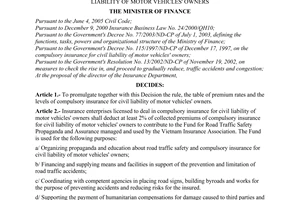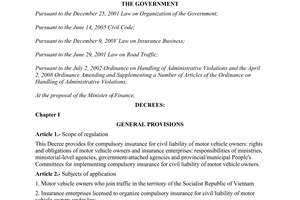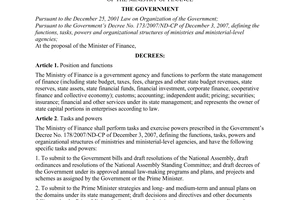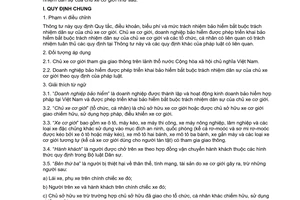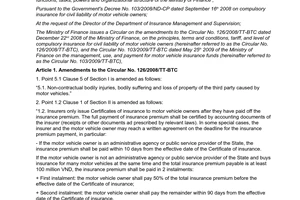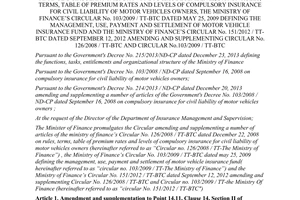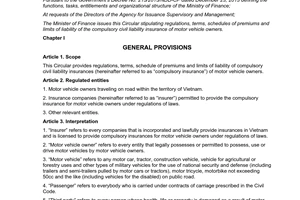Circular No. 126/2008/TT-BTC of December 22, 2008, on rules, terms, table of premium rates and levels of liability of compulsory insurance for civil liability of motor vehicle owners. đã được thay thế bởi Circular No. 22/2016/TT-BTC premiums limits liability compulsory civil liability insurance motor vehicle owners và được áp dụng kể từ ngày 01/04/2016.
Nội dung toàn văn Circular No. 126/2008/TT-BTC of December 22, 2008, on rules, terms, table of premium rates and levels of liability of compulsory insurance for civil liability of motor vehicle owners.
|
THE MINISTRY OF
FINANCE |
SOCIALIST
REPUBLIC OF VIET NAM |
|
No. 126/2008/TT-BTC |
Hanoi, December 22, 2008 |
CIRCULAR
ON RULES, TERMS, TABLE OF PREMIUM RATES AND LEVELS OF LIABILITY OF COMPULSORY INSURANCE FOR CIVIL LIABILITY OF MOTOR VEHICLE OWNERS
Pursuant to the Governments
Decree No. 118/2008/ND-CP of November 27, 2008, defining the functions, tasks,
powers and organizational structure of the Ministry of Finance;
Pursuant to the Governments Decree No. 103/2008/ND-CP of September 16, 2008, on
compulsory insurance for civil liability of motor vehicle owners;
The Ministry of Finance prescribes rules, terms, table of premium rates and
levels of liability of compulsory insurance for civil liability of motor
vehicle owners as follows:
I. GENERAL PROVISIONS
1. Scope of regulation:
This Circular prescribes rules, terms, table of premium rates and levels of liability of compulsory insurance for civil liability of motor vehicle owners. Motor vehicle owners and insurers permitted for compulsory insurance for civil liability of motor vehicle owners and concerned organizations and individuals shall comply with this Circular and other relevant laws.
2. Subjects of application
2.1. Owners of motor vehicles running on roads in the territory of the Socialist Republic of Vietnam.
2.2. Insurers licensed for compulsory insurance for civil liability of motor vehicle owners under law.
3. Interpretation of terms
3.1. Insurer means an enterprise lawfully established and engaged in insurance business in Vietnam and licensed to provide compulsory insurance for civil liability of motor vehicle owners.
3.2. Motor vehicle owner (organization or individual) means the owner of a motor vehicle or a person authorized by the motor vehicle owner to legally possess, use or drive that motor vehicle.
3.3. Motor vehicle means an automobile, tractor, construction vehicle or machine, agricultural or forestry vehicle or machine or a special vehicle used for security or defense purpose (including trailers and semi-trailers pulled by automobiles or tractors), two-wheeled motorcycle, three-wheeled motorcycle, moped or a similar motor vehicle (including those for the disabled) which runs on roads.
3.4. Passenger means a person transported on a motor vehicle under a passenger transportation contract in any of the forms specified in the Civil Code.
3.5. Third party means a person suffering from loss of life, or bodily injury or property damage caused by a motor vehicle, other than the following persons:
a/ Driver or assistant driver of the vehicle;
b/ Persons and passengers on board;
c/ Owner of the vehicle, unless he/she/it has authorized another organization or individual to possess or use the vehicle.
3.6. Day (counted in a time limit) referred to in this Circular means a working day.
4. Principles for insurance participation
4.1. Owners of motor vehicles running on roads in the territory of the Socialist Republic of Vietnam shall participate in compulsory insurance for their civil liability under this Circular and other relevant laws.
4.2. A motor vehicle owner may not concurrently enter into two or more policies of compulsory insurance for civil liability for the same motor vehicle.
4.3. Apart from policies of compulsory insurance for civil liability, motor vehicle owners may also reach agreement with insurers on a voluntary insurance policy.
4.4. Insurers may, at their will, sell compulsory insurance for civil liability of motor vehicle owners by the following modes:
a/ Direct sale to motor vehicle owners;
b/ Through insurance agents or brokers;
c/ Other modes in accordance with law.
When compulsory insurance for civil liability of motor vehicle owners is sold through an insurance agent, this agent must satisfy the criteria specified in the Law on Insurance Business, its guiding documents and relevant laws.
An insurer may not use another insurers agents for sale of insurance for civil liability of motor vehicle owners, unless the latter so consents in writing and the former must train and issue insurance agent certificates to those agents according to regulations.
5. Scope of indemnification
5.1. Loss of life, bodily injury or property damage caused by motor vehicles to third parties.
2. Loss of life or bodily injury of passengers under passenger transportation contracts caused by motor vehicles.
II. SPECIFIC PROVISIONS
1. Policies of insurance for civil liability of motor vehicle owners
1.1. The certificate of compulsory insurance for civil liability of a motor vehicle owner (below referred to as insurance certificate) is the evidence of entry into a sole policy of compulsory insurance for civil liability between a motor vehicle owner and an insurer. Each motor vehicle is issued one insurance certificate. A motor vehicle owner who loses his/her insurance certificate shall request in writing the insurer (which has issued such certificate) to re-issue this certificate.
1.2. An insurer may issue an insurance certificate to a motor vehicle owner only when he/she has fully paid premiums. The full payment of premiums must be proven by accounting vouchers issued by the insurer (receipts, invoices or other vouchers under relevant laws).
1.3. Issuance, management and use of insurance certificates:
a/ An insurer may print its own insurance certificates according to the Finance Ministrys forms in Appendices 1 and 2 to this Circular (not printed herein). Insurance certificates of compulsory insurance for civil liability of motor vehicle owners shall be printed separately from certificates of voluntary insurance (if any). When an insurer combines certificates of compulsory insurance for civil liability of motor vehicle owners with those of voluntary insurance for motor vehicles, it shall comply with Appendix 3 to this Circular (not printed herein).
b/ Insurance certificates shall be printed with a number in the order of natural numbers.
c/ Insurance certificates shall be used according to their consecutive numbers given in each book (unless a certificate is voided due to mistaken writing or when the non-use of a certain number conforms with insurers specific rules on management of printed forms. Voided insurance certificates must be crossed out, written with the word void and fully kept by insurers).
d/ Insurers shall fully fill in insurance certificates as required. Information written on insurance certificates issued to motor vehicle owners must be identical with those on the copies filed at insurers.
e/ Insurers shall open record books to monitor the issuance, use and settlement of the use of, insurance certificates, ensuring constant control of every insurance certificate.
f/ Insurers shall develop a process to issue, manage and use insurance certificates to ensure compliance with the above regulations.
2. Insurance duration and validity
2.1. The starting time of validity of an insurance certificate is specified in the insurance certificate, but must not be prior to the time a motor vehicle owner fully pays premiums.
2.2. The validity of an insurance certificate is one year. In the following cases, the insurance duration may be less than one year:
a/ Foreign motor vehicles are temporarily imported for re-export and run on roads in the territory of the Socialist Republic of Vietnam for less than one year;
b/ The use life of motor vehicles is less than one year.
c/ Motor vehicles are temporarily registered under law, including:
- New automobiles, imported or locally assembled or manufactured, running from warehouses, ports, factories or sale agents to places of registration or other sale agents or warehouses;
- Automobiles under deregistration procedures for re-export;
- Automobiles permitted for transit (other than those under the States agreements);
- Chassis with separate cabs and open trucks;
- Automobiles under examination;
- Vehicles with number plates of trade-economic zones under the Governments regulations and operating in inland Vietnam;
- New vehicles assembled in Vietnam on trial run on public roads;
- Vehicles to be used for conferences or sports events at the request of the Government or the Ministry of Public Security;
- Other motor vehicles permitted for temporary registration under law.
2.3. Within the validity duration of an insurance certificate, if a motor vehicle changes hands, all insurance benefits related to the civil liability of the old motor vehicle owner remain valid for the new one.
3. Premiums
3.1. Premium means the amount a motor vehicle owner shall pay to an insurer for compulsory insurance for civil liability of motor vehicle owners. The premium rates for each type of motor vehicle are provided in Appendix 5 to this Circular.
3.2. For motor vehicles permitted for an insurance term of less than one year under Point 2.2, Party II of this Circular, premium rates shall be calculated based on the rates provided in Appendix 5 to this Circular and corresponding to the insurance duration specified in the insurance certificate, specifically:
|
Payable premiums |
= |
Annual premium by type of motor vehicle |
x |
Insurance duration (in days) |
|
365 (days) |
When the insurance duration is 30 days or less, payable premiums shall be calculated by dividing annual premiums by type of motor vehicle by 12 months.
4. Insurance liability levels
Insurance liability level means the maximum sum of money an insurer may be obliged to pay for the loss of life, or bodily injury or property damage caused by a motor vehicle to a third party and passengers in an insured accident, specifically:
4.1. The insurance liability level for human damage caused by a motor vehicle is VND 50,000,000/persort/accident.
4.2. The insurance liability level for property damage caused by a two-wheeled or three-wheeled motorcycle, moped or a similar motor vehicle (including motor vehicles used for the disabled) is VND 30,000,000/accident.
4.3. The insurance liability level for property damage caused by an automobile, tractor, construction, agricultural or forestry machine or vehicle or a special vehicle used for security and defense purposes (including trailers and semi-trailers pulled by automobiles or tractors) is VND 50,000,000/accident.
5. Cancellation of insurance policies
5.1. An insurance policy may be cancelled only in the following cases:
a/ The registration and number plate of the motor vehicle are withdrawn under law;
b/ The motor vehicles use life expires under law;
c/ The motor vehicle is lost as certified by a police office;
d/ The motor vehicle breaks down and is no longer usable or damaged in a traffic accident as certified by a police office.
5.2. When wishing to cancel an insurance policy, a motor vehicle owner shall notify in writing an insurer thereof and furnish the latter with the insurance certificate to be cancelled and evidence proving that the motor vehicle is eligible for insurance policy cancellation under Point 5.1, Part II of this Circular.
An insurance policy terminates as soon as an insurer receives a cancellation notice.
5.3. Within five days from the date of receiving a notice, an insurer shall refund the motor vehicle owner 70% of the premiums paid for the cancelled duration. An insurer is not obliged to refund premiums when an insurance policy remains valid and an insured event has occurred to a motor vehicle owner requesting cancellation of such insurance policy and the insurance indemnity liability has arisen.
5.4. When a motor vehicle owner does not notify an insurer of the insurance policy cancellation, but the insurer has specific evidence of the motor vehicles eligibility for insurance policy cancellation under Point 5.1, Part II of this Circular, the insurer shall notify such to the motor vehicle owner for carrying out insurance policy cancellation procedures. If the motor vehicle owner fails to carry out these procedures within 15 days from the date of receiving the notice, the insurance policy is automatically cancelled.
6. Assessment of damage
6.1. When an accident occurs, an insurer or a person authorized by an insurer shall closely collaborate with the motor vehicle owner, the third party or lawful representatives of involved parties in conducting assessment to identify the cause and level of loss. Assessment result reports shall be made and signed by involved parties. The insurer shall bear all assessment costs.
6.2. When a motor vehicle owner disagrees with the cause and level of damage identified by an insurer, the two parties may reach agreement on assessment conducted by an independent assessor. When the parties fail to reach such agreement, either of them may request a court of the locality where the loss occurs or where the motor vehicle owner resides to designate an independent assessor. The independent assessors written award is binding on the parties.
6.3. When an independent assessors award is different from that of the insurer, the insurer shall bear expenses for the independent assessment. When the independent assessors award matches that of the insurer, the motor vehicle owner shall bear expenses for the independent assessment.
6.4. When it is impossible to conduct an assessment in a special case, the insurer may base itself on records and written conclusions of competent functional agencies and relevant documents to identify the cause and extent of damage.
7. Insurance exemption
An insurer is not obliged to indemnify in the following cases:
7.1. Motor vehicle owners, drivers or victims intentionally commit acts of causing damage.
7.2. Drivers causing accidents intentionally flee, shirking the civil liability of motor vehicle owners or drivers.
7.3. Drivers have no valid driving licenses or inappropriate driving licenses for motor vehicles for which driving licenses are required.
7.4. The damage entails such circumstantial consequences as decrease in commercial value, loss associated with the use and exploitation of the damaged property.
7.5. The damage is property stolen or robbed in accidents.
7.6. Wars, terrorism, earthquakes.
7.7. The damage is caused to such special property as gold, silver, gems, money, papers of monetary value, antiques, precious and rare paintings and pictures, corpses and remains.
8. Principles of indemnification
8.1. When an accident occurs, an insurer shall, within the scope of its insurance liability, indemnify a motor vehicle owner for the sum the latter has compensated or is supposed to compensate for damage to a victim.
When the motor vehicle owner dies or suffers from permanent bodily injuries, the insurer shall directly indemnify the victim.
8.2. When necessary, an insurer shall promptly advance necessary and reasonable expenses within the scope of its insurance liability to remedy accident consequences.
8.3. Levels of insurance indemnities:
a/ Levels of insurance indemnities for loss of life and each type of injury are determined according to the table of indemnities for human damage in Appendix 6 to this Circular (not printed herein). When a court ruling is available, indemnities shall be based on such ruling, but will not exceed the insurance liability level.
When a number of motor vehicles cause an accident leading to human damage, the levels of indemnities shall be determined based on the degree of fault of each motor vehicle owner, but the aggregate amount will not exceed the insurance liability level.
b/ The level of indemnity for property damage for an accident shall be determined according to the actual damage and the degree of fault of the motor vehicle owner, but will not exceed the insurance liability level.
8.4. An insurer is not obliged to indemnify for the damage beyond the insurance liability levels set in Section 4, Part II of, and Appendix 6 (not printed herein) to, this Circular.
8.5. When a motor vehicle owner concurrently enters into several policies of compulsory insurance for civil liability for the same motor vehicle, the receivable indemnity shall be calculated under the insurance policy that takes effect first.
9. Indemnity dossiers
An insurer shall collaborate with the motor vehicle owner, victims, police and other concerned organizations and individuals in gathering documents related to the traffic accident to prepare an indemnity dossier. Such a dossier comprises:
9.1. Documents related to the motor vehicle and driver (true copies as certified by the insurer):
a/ Vehicle registration certificate;
b/ Driving license;
c/ Drivers identity card, passport or other personal papers;
d/ Insurance certificate.
9.2. Documents evidencing human damage (copies issued by a healthcare establishment or true copies as certified by the insurer), which, depending on the severity of human damage, may comprise one or more of the following documents:
a/ Injury certificate;
b/ Hospital discharge slip;
c/ Surgery certificate;
d/ Medical record;
e/ Death certificate (for a dead victim).
9.3. Documents evidencing property damage:
a/ Lawful invoices and vouchers for the vehicle owners repair or replacement of damaged property caused by a traffic accident at an establishment designated or approved by the insurer.
b/ Papers evidencing necessary and reasonable expenses paid by the vehicle owner to minimize loss or under the insurers instruction.
9.4. Copies of accident-related documents issued by a competent agency:
a/ Record of the examination of the accident scene;
b/ Plan of the accident scene, photos (if any);
c/ Records of the examination of the vehicle related to the accident;
d/ Report on the results of initial investigation of the accident;
e/ Other documents related to the accident (if any).
10. Time limits for claiming, paying and lodging complaints about indemnities
10.1 The time limit for claiming an indemnity by a motor vehicle owner is one year from the date of an accident, unless claims cannot be made within this time limit due to objective causes and force majeure circumstances under law.
10.2 Within five days from the date of an accident (except in force majeure circumstances), a motor vehicle owner shall send to an insurer a notice made according to the form in Appendix 4 to this Circular (not printed herein), enclosed with documents constituting a dossier of request for indemnity within his/her/its liability.
10.3. The time limit for an insurer to pay an indemnity is 15 days from the date of receiving a dossier of request for indemnity within the motor vehicle owners liability, and 30 days when verification of the dossier is required.
10.4. When rejecting indemnification, an insurer shall notify in writing the motor vehicle owner of the reason for rejection within 30 days from the date of receiving the dossier of request for insurance indemnity.
10.5. The statute of limitations for instituting a lawsuit about insurance indemnity is three years from the date an insurer pays or refuses to pay an indemnity. Past this time limit, the right to institute a lawsuit is invalidated.
11. Rights of motor vehicle owners
11.1. To select insurers to buy compulsory insurance for civil liability of motor vehicle owners.
11.2. To request insurers to explain and supply information relating to the entry into, performance and cancellation of insurance policies.
11.3. To request insurers to reduce insurance premium rates as appropriate for the remaining validity duration of insurance policies when there is a change in factors serving as bases for insurance premium calculation, which leads to fewer insured risks.
11.4. To request insurers to pay indemnities quickly, fully and timely under insurance policies.
11.5. To account insurance premiums as business expenses, for motor vehicle owners being production and business units; or to include insurance premiums in regular operation expenses, for motor vehicle owners being administrative agencies and non-business units of the State.
11.6. To have other rights under law.
12. Obligations of motor vehicle owners
12.1. To participate in compulsory insurance for civil liability of motor vehicle owners and fully pay premiums under this Circular and other relevant laws. When buying insurance, motor vehicle owners shall provide full and truthful information to be written on insurance certificates.
12.2. To create favorable conditions for insurers to inspect the actual conditions of motor vehicles before issuing insurance certificates.
12.3. To promptly notify insurers of any change in vehicle use purposes which leads to more or fewer insured risks in order to enjoy appropriate insurance premium rates for the remaining validity duration of insurance policies.
12.4. While on roads, always to bring along their valid insurance certificates and produce such certificates at the request of the traffic police and other competent functional agencies under law.
12.5. To observe road traffic safety rules.
12.6. When an accident occurs, a motor vehicle owner shall:
a/ Promptly notify the insurer of the accident for coordinated settlement, actively rescue and treat victims, mitigate human and property damage and protect the accident scene; and at the same time, report on the accident to the nearest police office or local administration;
b/ Refrain from moving, disassembling or repairing property without the insurers consent, unless it is necessary to assure safety and prevent and mitigate human and property damage or at the request of competent agencies;
c/ Supply documents in the dossier of request for indemnity specified at Points 9.1, 9.2 and 9.3 (when the insurer redresses and remedies damage, the motor vehicle owner is not required to supply the documents specified at Point 9.3.a), Part II of this Circular and create favorable conditions for the insurer to verify these documents.
12.7. To notify in writing insurers when their motor vehicles become eligible for insurance policy cancellation under Point 5.1, Part II of this Circular.
12.8. To notify and pay victims the indemnities paid by insurers in each case of human damage according to the levels set in Appendix 6 (not printed herein).
12.9. To perform other obligations under law.
13. Rights of insurers
13.1. To collect premiums for compulsory insurance for civil liability of motor vehicle owners under the Finance Ministrys regulations. To request motor vehicle owners to additionally pay premiums for the remaining validity duration of insurance policies when there is a change in factors serving as bases for insurance premium calculation, which leads to more insured risks.
13.2. To request motor vehicle owners to supply full and truthful information to be written on insurance certificates; to inspect the actual conditions of motor vehicles before issuing insurance certificates.
13.3. To request police offices to supply copies of documents related to accidents under Clause 3, Article 22 of Decree No. 103/2008/ND-CP.
13.4. To refuse to pay indemnities for cases falling beyond their insurance liability.
13.5. To propose amendments or supple-ments to rules, terms and table of premium rates of compulsory insurance for civil liability of motor vehicle owners to suit the practical implementation of this type of insurance.
13.6. To have other rights under law.
14. Obligations of insurers
14.1. To sell compulsory insurance for civil liability of motor vehicle owners in strict compliance with rules, table of premium rates and insurance liability levels under this Circular. When receiving motor vehicle owners notices of a change in factors serving as bases for insurance premium calculation which leads to fewer insured risks, to reduce premiums for the remaining validity duration of insurance policies and refund the difference to motor vehicle owners.
14.2. To widely propagate the regime on compulsory insurance for civil liability of motor vehicle owners; to fully supply information relating to insurance policies and clearly explain rules, terms and premium rates of compulsory insurance for civil liability of motor vehicle owners to motor vehicle owners.
14.3. To issue to motor vehicle owners insurance certificates made according to the forms in Appendices 1 and 2 and Appendix 3 (if any) to this Circular (not printed herein).
14.4. To refrain from providing financial supports in any form other than commissions for agents selling insurance for civil liability of motor vehicle owners under the Finance Ministrys regulations.
14.5. To refrain from conducting sale promotion in any form for compulsory insurance for civil liability of motor vehicle owners.
14.6. To pay police offices expenses for copying dossiers and records of accidents supplied to them, and keep confidential these dossiers and records throughout the investigation.
14.7. To gather required documents for indemnity dossiers specified at Point 9.3.a (when insurers redress and remedy damage) and Point 9.4, Part II of this Circular.
14.8. To notify victims and motor vehicle owners of indemnities for human damage and pay these indemnities at the levels set in Appendix 6 to this Circular (not printed herein).
14.9. To quickly and accurately pay indemnities under this Circular and other relevant laws.
14.10. To notify motor vehicle owners of the expiration of insurance policies at least 15 days in advance.
14.11. To deduct and contribute at least 2% of annually collected premiums of compulsory insurance for civil liability of motor vehicle owners to the Motor Vehicle Insurance Fund at the annual level set by the Ministry of Finance.
14.12. To account separately premium sales, commissions, indemnities and other expenses related to compulsory insurance for civil liability of motor vehicle owners.
14.13. To install and operate information technology systems to assure adequate statistics and updated information on the actual implementation of compulsory insurance for civil liability of motor vehicle owners to be linked with the database on compulsory insurance for civil liability of motor vehicle owners. Such database must at least supply the following information:
a/ Information on motor vehicle owners:
- Name;
- Identity card or passport number (for individual vehicle owners);
- Contact address.
b/ Information on motor vehicles:
- Registered number plate;
- Mark;
-Type;
- Capacity;
- Color;
- Year of manufacture;
- Engine number;
- Frame number;
- Load (for automobiles);
- Number of seats (for automobiles);
- Use purposes (business or non-business) (for automobiles);
- Insurance certificate number;
- Starting time of insurance validity;
- End of insurance validity;
- Premiums;
- Date of premium payment;
- Date of policy issuance;
- Place of policy issuance;
- Policy issuer.
c/ Records on drivers times of causing accidents and times of being handled for violations of the Road Traffic Law.
- Times of causing accidents (time, place, severity of violation according to the polices determination);
- Times of receiving indemnities, indemnity sums for each accident (details by accident);
- Times of being handled for violations of the Road Traffic Law (if any).
14.14. To report to the Ministry of Finance on the implementation of compulsory insurance for civil liability of motor vehicle owners periodically or at request, specifically:
a/ Periodical reporting as prescribed in Appendices 7 and 8 to this Circular (not printed herein).
b/ In addition to the reports specified in Appendices 7 and 8 (not printed herein), insurers shall report on compulsory insurance for civil liability of motor vehicle owners at the Finance Ministrys request.
Within 2 years from the effective date of this Circular, insurers shall develop a database meeting the requirements specified at Point 14.13, Part II of this Circular.
14.15. To submit to competent state agencies inspection and supervision of compulsory insurance for civil liability of motor vehicle owners.
14.16. To perform other responsibilities under law.
15. Dispute settlement
All disputes arising out of insurance policies shall be brought to courts in Vietnam for settlement if involved parties fail to negotiate on their own.
III. ORGANIZATION OF IMPLEMENTATION
1. This Circular takes effect 15 days after its publication in CONG BAO and replaces the Finance Ministers Decision No. 23/2007/QD-BTC of April 9, 2007, promulgating the regime on compulsory insurance for civil liability of motor vehicle owners.
2. Any problems arising in the implementation of this Circular should be promptly reported to the Ministry of Finance for consideration and settlement.
|
|
FOR THE FINANCE
MINISTER |
APPENDIX 5
PREMIUM RATES OF INSURANCE FOR CIVIL LIABILITY OF
MOTOR VEHICLE OWNERS
(To the Finance Ministrys
Circular No. 126/2008/TT-BTC of December 22, 2008)
|
No. |
Type of vehicle |
Annual premium (VND) |
|
I |
Two-wheeled motorcycles |
|
|
1 |
With capacity of 50cc or under |
55,000 |
|
2 |
With capacity of over 50cc |
60,000 |
|
|
|
|
|
II |
Three-wheeled motorcycles, mopeds and other similar motor vehicles |
265,000 |
|
|
|
|
|
III |
Automobiles not for commercial transportation |
|
|
|
|
|
|
1 |
Under 6 seats |
345,000 |
|
2 |
Between 6 and 11 seats |
690,000 |
|
3 |
Between 12 and 24 seats |
1,104,000 |
|
4 |
Over 24 seats |
1,587,000 |
|
5 |
Pickups |
811,000 |
|
|
|
|
|
IV |
Automobiles for commercial transportation |
|
|
|
|
|
|
1 |
Under 6 seats according to registration |
630,000 |
|
2 |
6 seats according to registration |
774,000 |
|
3 |
7 seats according to registration |
900,000 |
|
4 |
8 seats according to registration |
1,044,000 |
|
5 |
9 seats according to registration |
1,170,000 |
|
6 |
10 seats according to registration |
1,260,000 |
|
7 |
11 seats according to registration |
1,380,000 |
|
8 |
12 seats according to registration |
1,518,000 |
|
9 |
13 seats according to registration |
1,639,000 |
|
10 |
14 seats according to registration |
1,777,000 |
|
11 |
15 seats according to registration |
1,915,000 |
|
12 |
16 seats according to registration |
2,036,000 |
|
13 |
17 seats according to registration |
2,174,000 |
|
14 |
18 seats according to registration |
2,295,000 |
|
15 |
19 seats according to registration |
2,433,000 |
|
16 |
20 seats according to registration |
2,553,000 |
|
17 |
21 seats according to registration |
2,691,000 |
|
18 |
22 seats according to registration |
2,812,000 |
|
19 |
23 seats according to registration |
2,950,000 |
|
20 |
24 seats according to registration |
3,088,000 |
|
21 |
25 seats according to registration |
3,209,000 |
|
22 |
Over 25 seats |
3,209,000 + 30,000 x (number of seats - 25 seats) |
|
V |
Cargo automobiles (trucks) |
|
|
1 |
Under 3 tons |
656,000 |
|
2 |
Between 3 and 8 tons |
1,277,000 |
|
3 |
Between 8 and 15 tons |
1,760,000 |
|
4 |
Over 15 tons |
2,243,000 |
II. PREMIUMS IN SOME OTHER CASES
1. For taxis:
To equal 150% of the premium for vehicles for commercial transportation with the same number of seats set in Section IV.
2. For special-purpose automobiles:
To equal the premium for cargo vehicles of the same tonnage set in Section V.
3. For trailer-pulling vehicles:
To equal the premium for vehicles of over 15 tons.
4. For special-purpose machines or vehicles:
To equal the premium for cargo vehicles of under 3 tons set in Section V.
5. For buses
To equal the premium for vehicles not for commercial transportation with the same number of seats set in Section III.
(The above premiums are exclusive of the 10% value-added tax).
